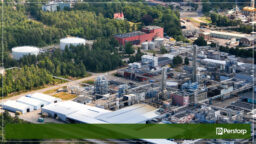Engineered polymer solutions
Trelleborg Sealing Solutions (TSS), a division of industrial group Trelleborg, is one of the world’s leading manufacturers of precision seals. The company serves aerospace, industrial and automotive customers across the globe, and its product portfolio includes some of the best-established sealing brands in the business.
The main production facility for Trelleborg’s high-performance automotive break components is in the town of Kalmar, in southern Sweden. Back in 2013, the management at TSS was becoming increasingly concerned with the situation at the facility. Production capacity issues were impacting delivery performance, and with long lead times to consider, purchasing struggled to order the right materials. To address the situation, a team of planning and procurement experts was assembled.
“What is the point of creating a great production plan if it is based on flawed input?”
Mattias Borén,
Logistics Manager
The team’s initial idea was to focus on production planning, since this was the area experiencing the most critical issues. However, as TSS began to engage with Optimity, those involved soon realised that the demand planning process had to be addressed first. Mattias Borén who is Logistics Manager at Trelleborg explains, “Optimity provided us with a lot of insight and really brought their experience to the table. We now know that it is common for companies to go after shop floor scheduling, whereas the real cause of the issues we were experiencing was a lack of reliable demand, supply and capacity plans to base our schedules on. After all, what is the point of creating a great production plan if it is based on flawed input?”
The bigger issue – demand planning
The production issues at the plant were, to a large extent, the result of inadequate demand planning. An outdated forecasting process together with a proliferated product portfolio – including aftermarket products with erratic demand patterns – was at the root of the problem. At the time, forecasting accuracy stood at just 35%.
Mattias explains, “Our forecasting process was supported by a set of Excel spreadsheets that had evolved over time and offered little support for those involved. As well as this, forecasting was done at the end-product level. In our case, this meant that forecasts for 1,500-2,000 products had to be reviewed and updated every month.” Many stakeholders found the task of generating a monthly forecast overwhelming, and the demand plan quality suffered as a result.
“Our forecasting process was supported by a set of Excel spreadsheets that had evolved over time and offered little support for those involved.”
Mattias Borén,
Logistics Manager
Raising the level of forecasting
Guided by Optimity, TSS decided to change the level at which forecasting was to take place to a semi-finished goods stage. This had the effect of reducing the number of forecasted materials to 250. Mattias explains, “As many of our finished products use the same type of materials, we identified several advantages to this approach. By forecasting a higher level, we were able to improve accuracy, and as a result, we could plan our stock and procurement activities in a better way. With our customer’s order patterns, for us to produce finished products directly towards forecast was simply too expensive and too risky.”
The project to implement Optimity’s Demand Forecaster in Kalmar started in October 2013. Four months later, TSS went live. “The implementation went very smoothly and delivered everything we’d set out to achieve,” says Mattias, who was leading the effort. “The rollout to the business was equally well-received. It addressed our core issues, and even though our process still requires manual confirmation of some of the forecast numbers, the improved baseline forecast accuracy offered by Optimity’s Demand Forecaster in combination with the move to semi-finished goods level forecasting, has given the business a real boost. Our forecast accuracy is now close to 80%. This is a huge improvement on the 35% we came from. The business now trusts the forecast and we’re all singing the same tune,” he continues.
“Our forecast accuracy is now close to 80%. This is a huge improvement on the 35% we came from. The business now trusts the forecast and we’re all singing the same tune.”
Mattias Borén,
Logistics Manager
Tightening up production planning
In early 2015, with the Optimity Demand Forecaster project running successfully, it was time to go to work on the factory planning solution. After six months, Optimity´s Supply Chain Optimizer was implemented and rolled out on five production lines.
As with the forecasting initiative a year earlier, there was a change in the focus of the project. The initial idea had been to implement a solution for detailed floor scheduling. But after some discussions, TSS decided again to focus efforts at a higher level, putting in place a solid weekly production planning solution.
“The cost-benefit for us to implement a really good weekly planning solution clearly outweighed the additional investment required to implement a detailed shop floor solution, where a lot more parameters and constraints had to be taken into account. We opted for a process where we refresh our weekly production plan every night, taking into account any changes in materials availability, shop floor capacity and any new customer orders. This gives us both the short-term accuracy we need to run the plant efficiently, as well as longer-term visibility (26 weeks) – enough time for us to properly plan for both plant capacity adjustments and materials acquisition,” says Mattias.
Jimmy Bertilsson, Purchasing Manager at TSS highlights another benefit of the new solution, “The visual components of Optimity’s solutions make the plans much more accessible. Our ERP solution presents everything as text and numbers. Optimity is completely different, as it conveys the most critical planning information in a very intuitive, graphical way. This really helps the communication within the business.”
Taking the guesswork out of planning
With Optimity Demand Forecaster and Supply Chain Optimizer both well-established at TSS, Mattias and Jimmy can look back on two successful rollouts.
Mattias summarises the journey, “We’ve come such a long way. We used to try to deal with so many materials that in the end we barely knew what to produce. We now have a complete solution telling us how many length-meters we should produce every week for each product. The plan is always up-to-date, based on real capacity constraints, and actual material availability. Guesswork is no longer part of the equation.”
“The plan is always up-to-date, based on real capacity constraints, and actual material availability. Guesswork is no longer part of the equation.”
Mattias Borén,
Logistics Manager
He continues to explain that prior to implementing Optimity, TSS registered a production order at the time of the actual production. Today, the planned manufacturing orders are visible in the ERP system for the next three weeks. These are simply firmed up prior to hitting the shop floor. This is a big improvement and provides visibility not only for production, but for the entire business.
Jimmy adds, “While overall stock levels remain roughly unchanged, our delivery performance is much better today. I cannot emphasize enough how critical this is to our business. Also, from the procurement side of things, we now get a purchasing plan from Optimity that we trust. Although some of the aftermarket products still present a challenge, we are today in a much better position to source the right amount of materials at competitive prices, at the right time.”
Looking ahead
There is always competition with other projects for budget and IT resources, but Mattias and Jimmy are already plotting their next moves. “Having seen what Optimity has brought to TSS in Kalmar, we are confident and keen to expand both the reach and the scope of the solution. The next target projects would likely be forecasting and inventory optimisation at our warehouses in Atlanta and Shanghai,” says Jimmy.
About Trelleborg
Trelleborg is a global engineering group focused on polymer technology. The company was founded in 1905 by Henry Dunker and Johan Kock in the Southern Swedish town of Trelleborg. Today, Trelleborg has operations in 50 countries and is a world leader in engineered polymer solutions that seal, damp and protect critical applications in demanding environments. Trelleborg Sealing Solutions (TSS) is a division of the Trelleborg Group.
Get all the latest industry trends, updates & news from Optimity
Trelleborg
Trelleborg, Sweden
23,000
31 billion SEK















